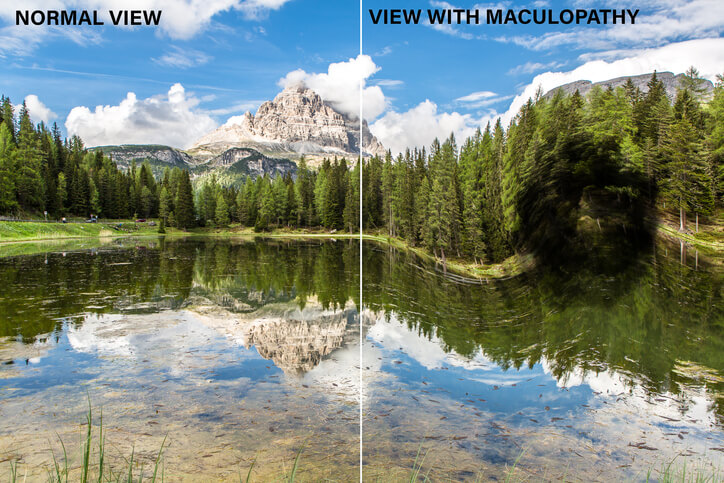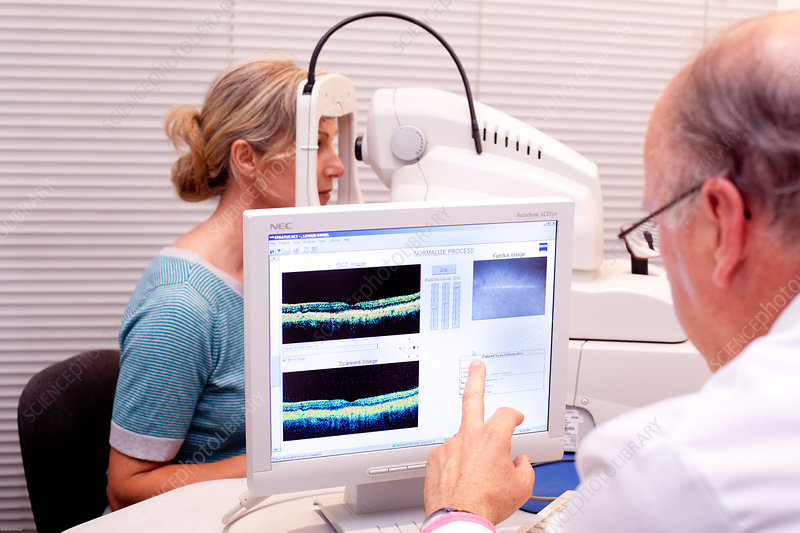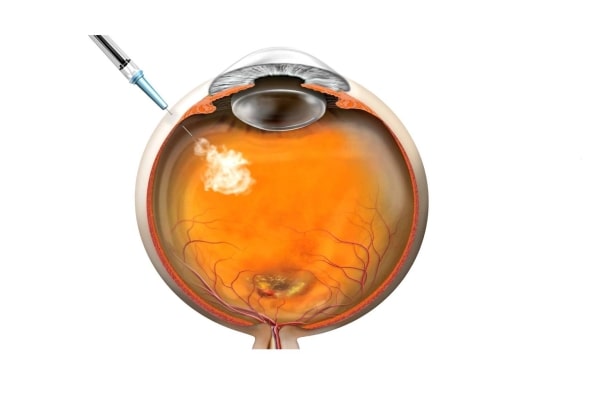AMD Injection Treatment: What You Need to Know
10 Jul 2025
Wet (neovascular) AMD is treated by injecting anti-VEGF drugs directly into the eye to block abnormal blood vessel growth. These medications neutralise excess Vascular Endothelial Growth Factor (VEGF), which the diseased retina overproduces. Excess VEGF drives new fragile vessels that leak fluid and blood, distorting central vision. By binding VEGF, intravitreal anti-VEGF injections slow or stop this process, preserving the retina. In other words, the injections help halt or reverse vision loss in wet AMD. Injections of anti-VEGF medicines are the main treatment for wet AMD
Overall, prompt anti-VEGF therapy protects central vision and can restore clarity, greatly improving quality of life for older patients.
How Do Anti-VEGF Injections Work?
Mechanism of anti-VEGF action
Anti-VEGF injections target the molecular cause of wet AMD. Normally VEGF regulates blood vessel growth. In wet AMD, retinal cells secrete too much VEGF, causing abnormal vessel proliferation and leakage. Injecting an anti-VEGF drug into the eye binds this excess VEGF protein, preventing it from stimulating new vessel growth. The result is reduced fluid leakage and halted abnormal vessel formation. Over time, as the retina dries out, vision loss can be slowed or stopped.
-
Mechanism: as well as other mechanisms in AMD, too much VEGF is produced by RPE cells, causing the growth and leakage of blood vessels. This process can be slowed or stopped by injecting drugs into the eye that bind and inhibit VEGF
-
Effect: Blocking VEGF stops new vessel growth and fluid leakage, which preserves the cell function of cells in the macula.
-
Outcome: Many patients experience stabilisation of vision, and some even see improvements. In trials, certain anti-VEGF treatments produced meaningful vision gains in a significant number of patients
Commonly Used Medications for AMD
Anti-VEGF Injection Drugs
Several anti-VEGF drugs are approved for wet AMD. At our clinic in Birmingham, we customise treatment choice based on each patient’s needs. Common options include:
-
Eylea (aflibercept). A reliable drug that has been used for many years. Eylea HD is also now available as a high-dose form that has prolonged durability.
-
Lucentis (ranibizumab). A long-established anti-VEGF, usually administered monthly.
-
Vabysmo (faricimab). A newer dual-action drug targeting VEGF and ANG‑2; can extend the interval between injections in some cases and is often used first-line
-
Beovu (brolucizumab). Another licensed option, though less commonly used due to specific safety considerations.
-
Avastin (bevacizumab, off-label). A cancer drug used off-license in the UK; NHS-approved ophthalmic formulation (Lytenava) is now available
All these medications inhibit VEGF, but they differ slightly in dosing frequency and molecular structure. We discuss the benefits and dosing schedules of each with patients. For example, some drugs may need monthly injections, while others allow longer intervals. As NICE reports, five anti-VEGF agents are licensed for wet AMD in the UK (aflibercept, ranibizumab, brolucizumab, faricimab, and bevacizumab gamma).
Mr. Sahota has extensive experience using all of these drugs and will answer any questions that you have about any of the choices.

When Are AMD Injections Needed?
Wet AMD- risk of sight loss
Wet AMD often manifests as a rapid change in central vision. Key signs prompting treatment include: distortion (straight lines becoming wavy), blurring, or a gray/dark patch at the centre of your vision. Patients may notice everyday objects (like text or faces) become harder to see clearly. These are “metamorphopsia” and central scotoma, classic wet AMD symptoms.
After any new symptoms, an ophthalmologist confirms disease activity with retinal imaging. An Optical Coherence Tomography (OCT) scan or OCT-Angiography (OCT-A) will typically show fluid and an abnormal blood vessel network in the macula. Treatment is urgent: expert advice is to not delay if new distortion or blurring occurs. Untreated wet AMD can damage the macula in days to weeks.
In summary:
-
Warning signs: sudden onset of distortion (wavy lines) or central blur. Even a small blind spot or patch in the centre of vision is a red flag.
-
Diagnosis: confirm fluid and/or blood vessel on OCT/OCT-A scan.
-
Urgency: Wet AMD can progress quickly; early treatment is vital. Quick action gives the best chance to protect vision.

What to Expect During the Injection
If injections are needed, here’s what happens at your appointment:
-
Preparation: Numbing eye drops are applied first, so you shouldn’t feel pain. The eye area is cleaned with antiseptic (iodine drops), and a sterile drape is placed around the eye. A device gently holds the eyelids open for the injection.
-
Injection: The actual intravitreal injection is very quick – usually under 30 seconds. You may feel pressure or a pinch, but not sharp pain. Most patients report it feels like slight discomfort only. (Indeed, studies note people find it “not as bad as they originally thought” when the eye is properly numbed.)
-
Comfort measures: We will have you listen to music to relax. Throughout, we reassure you and ensure comfort; it’s normal to feel a tiny pressure.
-
Aftercare: Immediately after the injection, your vision may be blurry for a short time. Mild watering, a gritty sensation, or a faint red spot on the white of the eye (from the injection) are common and not harmful. You should avoid heavy activity or water going into the eye for 48 hours. Most people return to normal activities the following day.
-
Follow-up: Usually, injections start monthly for 3-4 months (“loading” phase) and then space out based on response. We monitor with OCT scans to decide timing. Regular follow-up is essential to catch any new fluid early.

Side Effects and Safety
Anti-VEGF injections have an excellent safety record when done correctly by a trained ophthalmologist. Side effects are usually mild:
-
Common (mild): After the injection your eye may feel gritty or irritated, and it might water. The whites of the eye can be red for a day or two (due to a tiny bleed at the injection site). These symptoms typically resolve quickly.
-
Rare (serious): Endophthalmitis (infection inside the eye) is rare (about 1 in 2,000 injections. Retinal detachment or a tear is also very uncommon (~1/1000). We take precautions (like iodine prep) to minimize these risks. If infection occurs, it causes pain, vision loss, and is treated aggressively with antibiotic injections. Retinal tear/detachment risk is low; symptoms would be new floaters or flashes and require urgent surgery.
-
Other: A small temporary rise in eye pressure can occur immediately after injection. Allergic reactions are exceedingly rare.
Overall, as long as you are receiving expert care (such as at our Moorfields-trained Macular Clinic), intravitreal anti-VEGF has a strong safety profile. The benefit of protecting sight overwhelmingly outweighs these small risks.
In short, most patients tolerate injections well, with only minor expected after-effects. Serious complications are uncommon, especially with expert technique and follow-up.
FAQ: Common Questions
Are AMD injections painful?
No. Your eye is numbed with anaesthetic drops first, so you should feel only pressure or slight discomfort at most. The brief injection itself is over in a few seconds and many patients report it was easier than they feared. You might feel a brief poke, but no sharp pain
How often do I need AMD injections?
Typically, injections are given monthly (about every 4 weeks) for the first 2–3 doses. After that, we often reduce frequency based on how your eye responds. With newer drugs and “treat-and-extend” approaches, many patients shift to injections every 2–3 months. The exact schedule is tailored to your OCT findings and vision changes.
What happens if I delay AMD injections?
Delaying treatment for wet AMD is risky. Wet AMD can worsen quickly and cause permanent vision loss. Clinical guidance strongly urges prompt treatment. Early injections can stop damage, whereas delay may lead to irreversible sight loss. There is clear evidence that the longer you wait the less chance you have of regaining more vision.
Can injections improve vision?
Yes – many patients not only stabilise their vision but actually see improvement. By reducing fluid and damaging vessels, the macula can recover. In fact, studies show a significant portion of people gain vision letters on an eye chart after starting anti-VEGF therapy. The sooner treatment begins, the better the chance of regaining clear sight.
Protect Your Vision Today
Don’t wait to treat wet AMD
Protect your central vision with an expert-led approach. Book a free 10-minute video consultation Mr. Sahota in Birmingham now, and get personalised advice on AMD injections and care.
For more on treatment options and support, visit our pages on wet AMD retina treatments and macular degeneration treatment costs or learn about choosing the right private eye doctor in Birmingham for your care. We are a consultant-led eye clinic in Edgbaston, Birmingham, specialising in macular conditions – ready to help you see clearly again for a brighter future.
